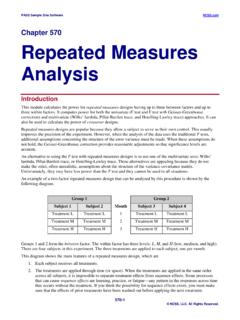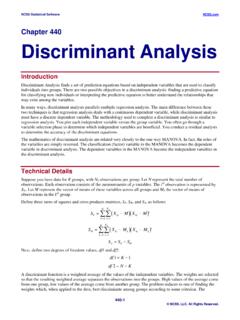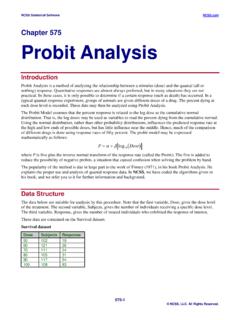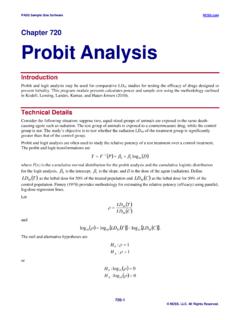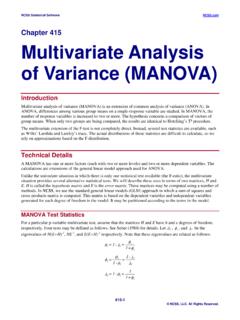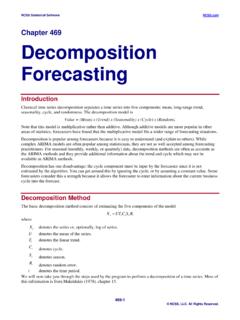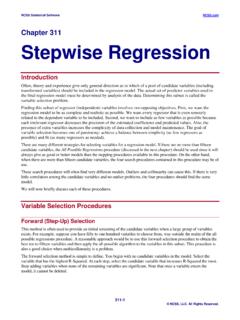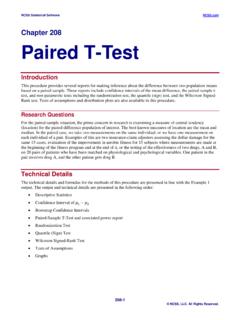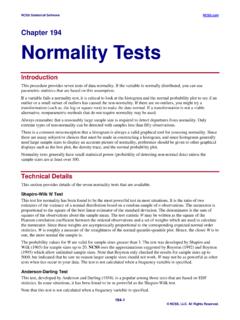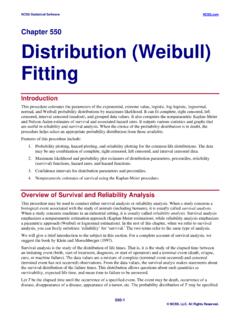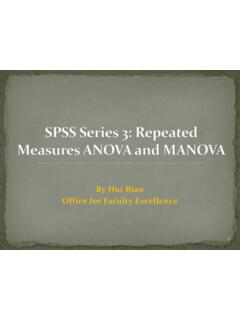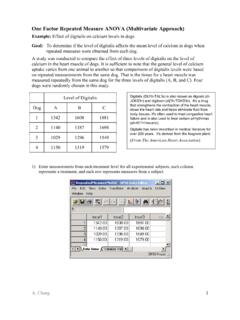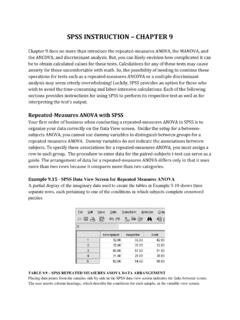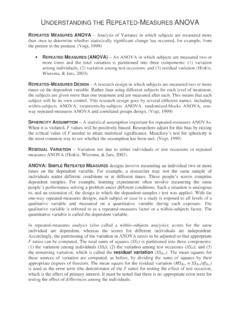Transcription of Mixed Models - Repeated Measures - Statistical …
1 NCSS Statistical Software 222-1 NCSS, LLC. All Rights Reserved. Chapter 222 Mixed Models Repeated Measures Introduction This specialized Mixed Models procedure analyzes results from Repeated Measures designs in which the outcome (response) is continuous and measured at fixed time points. The procedure uses the standard Mixed model calculation engine to perform all calculations. However, the user-interface has been simplified to make specifying the Repeated Measures analysis much easier. These designs that can be analyzed by this procedure include Split-plot designs Repeated - Measures designs Cross-over designs Designs with covariates This chapter gives an abbreviated coverage of Mixed Models in general. We rely on the Mixed Models - General chapter for a comprehensive overview. We encourage you to look there for details of Mixed Models . Types of Factors It is important to understand between-subject factors and within-subject factors.
2 Between-Subject Factors Each subject is assigned to only one category of a each between-subject factor. For example, if 12 subjects are randomly assigned to three treatment groups (four subjects per group), treatment is a between-subject factor. Within-Subject Factors Within-subject factors are those in which the subject s response is measured at several time points. Within-subject factors are those factors for which multiple levels of the factor are measured on the same subject. If each subject is measured at the low, medium, and high level of the treatment, treatment is a within-subject factor. NCSS Statistical Software Mixed Models - Repeated Measures 222-2 NCSS, LLC. All Rights Reserved. Random versus Repeated Error Formulation The general form of the linear Mixed model as described earlier is y = X + Zu + u ~ N(0,G) ~ N(0,R) Cov[u, ] = 0 V = ZGZ' + R The specification of the random component of the model specifies the structure of Z, u, and G.
3 The specification of the Repeated (error or residual) component of the model specifies the structure of and R. Most of the designs available in this procedure use only the Repeated component. The exception is that a compound symmetric, random effects design can be generated that uses a diagonal Repeated component. Determining the Correct model of the Variance-Covariance of Y Akaike Information Criterion (AIC) for model Assessment Akaike information criterion (AIC) is tool for assessing model fit (Akaike, 1973, 1974). The formula is pLAIC22+ = where L is the (ML or REML) log-likelihood and p depends on the type of likelihood selected. If the ML method is used, p is the total number of parameters. If the REML method is used, p is the number of variance component parameters. The formula is designed so that a smaller AIC value indicates a better model . AIC penalizes Models with larger numbers of parameters.
4 That is, if a model with a much larger number of parameters produces only a slight improvement in likelihood, the values of AIC for the two Models will suggest that the more parsimonious (limited) model is still the better model . As an example, suppose a researcher would like to determine the appropriate variance-covariance structure for a longitudinal model with four equal time points. The researcher uses REML as the likelihood type. The analysis is run five times, each with a different covariance pattern, and the AIC values are recorded as follows. Pattern Number of Parameters -2 log-likelihood AIC Diagonal 1 Compound Symmetry 2 AR(1) 2 Toeplitz 4 Unstructured 7 The recommended variance-covariance structure among these five is the Toeplitz pattern, since it results in the smallest AIC value. NCSS Statistical Software Mixed Models - Repeated Measures 222-3 NCSS, LLC.
5 All Rights Reserved. What to Do When You Encounter a Variance Estimate that is Equal to Zero It is possible that a Mixed Models data analysis results in a variance component estimate that is negative or equal to zero. When this happens, the fitted model should be changed by selecting a different Repeated component, by selecting a grouping factor, or by selecting different fixed factors and covariates. Fixed Effects A fixed effect (or factor) is a variable for which levels in the study represent all levels of interest, or at least all levels that are important for inference ( , treatment, dose, etc.). The fixed effects in the model include those factors for which means, standard errors, and confidence intervals will be estimated and tests of hypotheses will be performed. Other variables for which the model is to be adjusted (that are not important for estimation or hypothesis testing) may also be included in the model as fixed factors.
6 Fixed factors may be discrete variables or continuous covariates. The correct model for fixed effects depends on the number of fixed factors, the questions to be answered by the analysis , and the amount of data available for the analysis . When more than one fixed factor may influence the response, it is common to include those factors in the model , along with their interactions (two-way, three-way, etc.). Difficulties arise when there are not sufficient data to model the higher-order interactions. In this case, some interactions must be omitted from the model . It is usually suggested that if you include an interaction in the model , you should also include the main effects ( individual factors) involved in the interaction even if the hypothesis test for the main effects in not significant. Covariates Covariates are continuous measurements that are not of primary interest in the study, but potentially have an influence on the response.
7 Two types of covariates typically arise in Mixed Models designs: subject covariates and within-subject covariates This procedure permits the user to make comparisons of fixed-effect means at specified values of covariates. Commonly, investigators wish to make comparisons of levels of a factor at low, medium, and high values of covariates. Multiple Comparisons of Fixed Effect Levels If there is evidence that a fixed factor of a Mixed model has difference responses among its levels, it is usually of interest to perform post-hoc pair-wise comparisons of the least-squares means to further clarify those differences. It is well-known that p-value adjustments need to be made when multiple tests are performed (see Hochberg and Tamhane, 1987, or Hsu, 1996, for general discussion and details of the need for multiplicity adjustment). Such adjustments are usually made to preserve the family-wise error rate (FWER), also called the experiment-wise error rate, of the group of tests.
8 FWER is the probability of incorrectly rejecting at least one of the pair-wise tests. We refer you to the Mixed Models chapter for more details on multiple comparisons. NCSS Statistical Software Mixed Models - Repeated Measures 222-4 NCSS, LLC. All Rights Reserved. Specifying the Within-Subjects Variance-Covariance Matrix The R Matrix The R matrix is the variance-covariance matrix for errors, . When the R matrix is used to specify the variance-covariance structure of y, the Gsub matrix (the random component) is not used. The full R matrix is made up of N symmetric R sub-matrices, =NR0000R0000R0000RR 321 where NRRRR,,,,321 are all of the same structure, but, unlike the Gsub matrices, differ according to the number of Repeated measurements on each subject. When the R matrix is specified in NCSS, it is assumed that there is a fixed, known set of Repeated measurement times.
9 Thus, the differences in the dimensions of the R sub-matrices occur only when some measurements for a subject are missing. As an example, suppose an R sub-matrix is of the form =2524232221 SubR, where there are five time points at which each subject is intended to be measured: 1 hour, 2 hours, 5 hours, 10 hours, and 24 hours. If the first subject has measurements at all five time points, then n1 = 5, and the sub-matrix is identical to RSub above, and R1 = RSub. Suppose the second subject is measured at 1 hour, 5 hours, and 24 hours, but misses the 2-hour and 10-hour measurements. The R2 matrix for this subject is =2523212 R. For this subject, n2 = 3. That is, for the case when the time points are fixed, instead of having missing values in the R sub-matrices, the matrix is collapsed to accommodate the number of realized measurements. NCSS Statistical Software Mixed Models - Repeated Measures 222-5 NCSS, LLC.
10 All Rights Reserved. Structures of R There are many possible structures for the sub-matrices that make up the R matrix. The RSub structures that can be specified in NCSS are shown below. Diagonal Homogeneous Heterogeneous Correlation 2222 24232221 1111 Compound Symmetry Homogeneous Heterogeneous Correlation 2222222222222222 24342414432323134232221241312121 1111 AR(1) Homogeneous Heterogeneous 2222232222222222232222 24342421434323231324223222124133122121 Correlation 1111232232 NCSS Statistical Software Mixed Models - Repeated Measures 222-6 NCSS, LLC. All Rights Reserved. Toeplitz Homogeneous Heterogeneous 2212223212212222212212322212 2434124214343123231132422321221214133122 1121 Correlation 1111123112211321 Toeplitz(2) Homogeneous Heterogeneous 2212122121221212 24341431232313212212121121 Correlation 1111111111 Note: This is the same as Banded(2).
